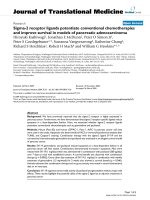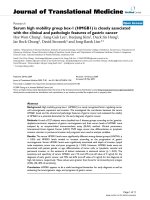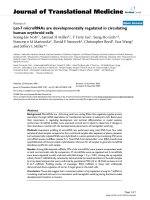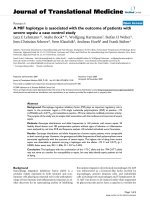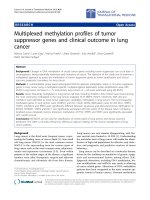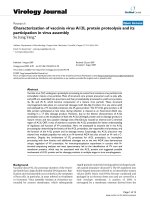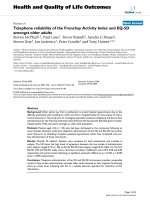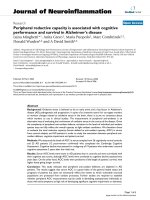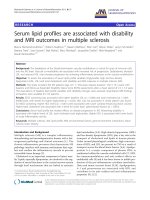báo cáo hóa học: " Serum lipid profiles are associated with disability and MRI outcomes in multiple sclerosis" pptx
Bạn đang xem bản rút gọn của tài liệu. Xem và tải ngay bản đầy đủ của tài liệu tại đây (261.94 KB, 7 trang )
RESEARCH Open Access
Serum lipid profiles are associated with disability
and MRI outcomes in multiple sclerosis
Bianca Weinstock-Guttman
1*
, Robert Zivadinov
1,2
, Naeem Mahfooz
1
, Ellen Carl
2
, Allison Drake
1
, Jaclyn Schneider
1
,
Barbara Teter
1
, Sara Hussein
2
, Bijal Mehta
1
, Marc Weiskopf
1
, Jacqueline Durfee
2
, Niels Bergsland
1,2
and
Murali Ramanathan
1,3*
Abstract
Background: The breakdown of the blood-brain-barrier vascular endothelium is critical for entry of immune cells
into the MS brain. Vascular co-morbidities are associated with increased risk of progression. Dyslipidemia, elevated
LDL and reduced HDL may increase progression by activating inflammatory processes at the vascular endothelium.
Objective: To assess the associations of serum lipid profile variables (triglycerides, high and low density
lipoproteins (HDL, LDL) and total cholesterol) with disability and MRI measures in multiple sclerosis (MS).
Methods: This study included 492 MS patients (age: 47.1 ± 10.8 years; disease duration: 12.8 ± 10.1 years) with
baseline and follow-up Expanded Disability Status Score (EDSS) assessments after a mean period of 2.2 ± 1.0 years.
The associations of baseline lipid profile variables with disability changes were assessed. Quantitative MRI findings
at baseline were available for 210 patients.
Results: EDSS worsening was associated with higher baseline LDL (p = 0.006) and total cholesterol (p = 0.001,
0.008) levels, with trends for higher triglyceride (p = 0.025); HDL was not associated. A similar pattern was found
for MSSS worsening. Higher HDL levels (p < 0.001) were associated with lower contrast-enhancing lesion volume.
Higher total cholesterol was associated with a trend for lower brain parenchymal fraction (p = 0.033).
Conclusions: Serum lipid profile has modest effects on disease progression in MS. Worsening disability is
associated with higher levels of LDL, total cholesterol and triglycerides. Higher HDL is associated with lower levels
of acute inflammatory activity.
Keywords: Multiple sclerosis, diet, lipid profile, MRI, environmental factors, gene-environment interactions, lesion
volume, brain atrophy
Introduction and Background
Multiple sclerosis (MS) is a complex inflammatory,
demyelinating and neurodegenerative disease with a het-
erogeneous pathology and clinical outcomes [1]. The
chronic inflammatory processes that characterize MS
pathology interfere with immune mechanisms that regu-
late and confine the inflamma tory cascade to prevent
irreversible tissue damage [2].
Cholesterol is an important component o f intact mye-
lin. Lipids, especially lipoproteins, are involved in the reg-
ulation of neural functions in the central nervous system
through local mechanisms that are linked to systemic
lipid metabolism [3,4]. High-density lipoproteins (HDL)
and low-density lipoproteins (LDL) play a key role in the
transport of chol esterol and lipids in human pl asma.
Under normal physiological conditions, high concentra-
tions of HDL and LDL are present in CNS as a result of
transport across the blood-brain barrier [5,6]. Apolipo-
protein A-I, a major compo nent of plasma HDL, is
synthesized within the vascular endothelial cells [7]. HDL
has immunomodulatory and ant i-oxidant effects on
endothelial cells [8] and it has been shown to inhibit pro-
duction of the pro-inflammatory cytokines interleukin-
1beta and tumor necrosis factor [9,10]. Apolipoprotein
A-1 and pa raoxonase a re associat ed with HDL and
contribute to its anti-oxidant and anti-inflammatory
properties [9,11,12].
* Correspondence: ;
1
Department of Neurology, State University of New York, Buffalo, NY, USA
Full list of author information is available at the end of the article
Weinstock-Guttman et al . Journal of Neuroinflammation 2011, 8:127
/>JOURNAL OF
NEUROINFLAMMATION
© 2011 Weinsto ck-Guttman et al; licensee BioMed Central Ltd. This is an Open Acce ss article distribu ted under the terms of the
Creative Comm ons Attribution License ( which permi ts unrestricted use, distribution, and
reproduction in any medium, provided the original work is properly cited.
Dyslipidemia can potentiate inflammatory processes at
the vascular endothelium, lead to the induction of adhe-
sion molecules, and the recruitment of monocytes
[13-15]. Associations between dyslipidemia and increased
inflammation are well established in conditions such
atherosclerosis, cardiovascular disease, metabolic syn-
drome and obesity [16].
In the context of autoimmune diseases, a strong associa-
tion between dyslipidemia and cardiovascular disease has
emerged in systematic lupus erythematosus [17] and
increased cardiovascular risk and lipid profile changes
have been reported in rheumatoid arthritis [18]. HDL and
LDL also modulate the function and survival of b-cells in
Type 2 diabetes mellitus [19]. Neuromyelitis optica
patients were reported to have significantly higher serum
cholesterol triglycerides and lower LDL than healthy
controls [20].
However, only limited information is available on the
effect of serum triglycerides and cholesterol levels and
the roles of HDL and LDL levels on MS disease progres-
sion. Increased total cholesterol w as associated with
increases in the number of contrast-enhancing lesions on
brain MRI in clinically isolated syndrome patients follow-
ing a first clinical demyelinating e vent [21]. MS patients
were found to have a higher oc currence of hypercholes-
terolemia and paraoxonase-1, the anti-oxidant enzyme
associated with HDL, was decreased during relapses [12].
A retrospective analysis of a large dataset of 8,983
patients from the North American Research Committee
on Multiple Sclerosis Registry reported that the presence
of vascular comorbidities linked to dyslipidemia was
associated with an increased risk for disability progres-
sion in MS [22].
The aim of this study therefore was to assess the associa-
tions of serum lipid prof ile variables (serum cholesterol,
HDL, LDL and triglycerides) to clinical disability and brain
tissue integrity as measured with quantitative magnetic
resonance imaging (MRI) metrics in a large cohort of MS
patients.
Methods
Study Population
Ethics Statement
ThestudywasapprovedbytheUniversityatBuffalo
Human Subjects Institutional Review Board. The Institu-
tional Review Board approval waived the requirement for
informed consent.
Study Design
Single-center, retrospective, longitudinal study.
Study Population
The study population included consecutive p atients, fol-
lowedattheBairdMSCenter,StateUniversityofNew
York, Buffalo, NY, with clinically definite MS patients
according to the McDonal d criteria [23] with available
baseline EDSS assessment within ± 6 months of lipid
profile testing and a follow-up EDSS assessment ≥ 6
months from the baseline clinical visit. Patients with CIS
and neuromyelitis optica were not included.
The collected data included demographic and clinical
information, statin use history, height and weight and fast-
ing lipid profile laboratory values: HDL, LDL, triglycerides,
total cholesterol and cholesterol to HDL ratio.
The exclusion criteria consisted of: any relapse with cor-
ticosteroid treatment at the time or within one month pre-
ceding study entry or MRI examination, pre-existing
medical conditions known to be associated w ith brain
pathology (e.g., neurodegenerative disorders, cerebrovas-
cular d isease, positive history of alcohol abuse, etc.),
and insufficient quality of the MRI scan for qua ntitative
analysis [24].
MRI Analysis
Quantitative MRI analysis obtained within ± 3 months
from the baseline clinical visit (yielding EDSS and f ast-
ing cholesterol levels) was available for 210 of 492
patients at baseline. MRI image analysis was conducted
at the Buffalo Neuroimaging Analysis Center using
approaches previously described [25,26]. MRI analysts
were blinded to lipid profile and clinical status. The
standardized acquisition and analysis methods for
obtaining contrast-enhancing lesion volume (CE-LV),
CE lesion number (CEL number), T2-LV, T1-LV and
brain parenchymal fraction (BPF) are detailed in Addi-
tional File 1.
Data Analysis
SPSS (SPSS Inc., Chicago, IL , version 15.0) statistical
program was used for all statistical analyses.
One-wayANOVAfollowedbypost-hocindependent
sample t-tests were used to test for differences in means
of continuous demograp hic variables such as age, age of
onset, and disease duration. The
2
test was used for ana-
lysis of count va riables for categorical data and the
Fisher exact test was used where appropriate.
The MS Severity Scale (MSSS) was calculated from
the EDSS and disease duration values using software
downloaded from />MSgenetics/GAMES/MSSS/Readme.html. The global
reference data set provided with the software was used
for calculations.
The difference between EDSS at follow-up and EDSS at
baseline was analyzed as the dependent variable in
regression analysis with gender, disease durati on at base-
line EDSS, EDSS at baseline, time difference between fol-
low-up and baseline EDSS assessments, statin use and a
lipid profile variable of interest (either HDL, LDL, trigly-
cerides, total cholesterol or cholesterol to HDL ratio) as
predictor variables. The difference between MSSS at
Weinstock-Guttman et al . Journal of Neuroinflammation 2011, 8:127
/>Page 2 of 7
follow-up and MSSS at baseline was analyzed in the same
manner as the EDSS; however, the MSSS at baseline was
included as a predictor in place of EDSS at baseline and
the disease duration was not included as a predictor vari-
able. Similar regression analyses were also conducted in
the subset of patients who were not on statins to assess
the contributions of lipid profile variables in the absence
of statin treatment.
Baseline EDSS was dichotomized into two groups
based on EDSS < 4.0 and ≥ 4.0. The baseline EDSS
groups were analyzed using logistic regression with sex
as a factor and disease duration and lipid profile variable
of interest.
The CE-LV, T 2-LV and T1-LV data were normalized
by cube-root transformation to reduce skew. The cube-
root-transformed T2-LV and T1-LV values were ana-
lyzed as dependent variables using multiple linear regres-
sion. The presence/absence of CE lesions (CEL) was
analyzed with logistic regression and the CEL number
was analyzed with Poisson loglinear regression and the
transformed CE-LV values were analyzed with Tweedie
regression [27]. All regression MRI analyses included sex,
disease duration at time of MRI, statin use, and a lipid
profile variable of interest (either HDL, LDL, triglycer-
ides, total cholesterol or cholesterol to HDL ratio) as pre-
dictor variables. Regression analyses were also conducted
in the subset of patients who were not on statins to assess
the contributions of lipid profile variables in the absence
of statin treatment.
To correct for the multiple testing involved, a conserva-
tive Type I error level of 0.01 was used to assess signifi-
cance; a trend was assumed if the Type I error level ≤ 0.10.
Results
Demographic and Clinical Characteristics
The clinical, demographic and MRI features of the cohort
are summarized in Table 1. The frequency of Caucasian-
Americans was 422 (85.8%), African-Americans was 28
(5.7%), Hispanics was 5 (1%), Native American 1 (0.2%),
and the racial information for 34 (6.9%) patients wa s
missing.
The median absolute time difference between lipid
profile and baseline EDSS assessment was 25 days
(Inter-quartile range: 51 days). The median absolute
time difference between MRI and lipid profile assess-
ments was 30 days (Inter-quartile range: 46 days). The
median time between baseline EDSS and follow-up
EDSS was 1.88 years (Inter-quartile range: 1.62 years).
The majority of patients were on disease-modifying
therapies: 45% were on interferon-beta-1a monotherapy,
0.8% were on interferon-beta-1b monotherapy, 14% were
on glatiramer acetate, 20% were on natalizumab, 8% were
on no therapy and the remainder were on combination
therapies or chemotherapies.
MRI data were available for 210 patients. There was no
evidence for lipid profile differences between the groups
with and without MRI available (See Additional File 1,
Table S1). The group with MRI differed from the group
without MRI in the higher frequency o f progressive
forms of MS and a modestly shorter time between base-
line EDSS and follow up EDSS (See Additional File 1,
Table S1).
The frequency of statin usage was 109/491 patients
(22.2%). There was no evidence for differences in the
groups with and without statin treatment in the lipid
profi le variables including HDL, LDL, triglycerides, total
cholesterol and cholesterol to HDL. Not surprisingly,
the group on statin treatment had a higher proportion
of males, greater mean age, disease duration, BMI and
baseline EDSS than the group not on statin treatment
(Table 2).
The frequency of disease-modifying therapy usage in the
group on statin treatment (51% interferon-beta 1a, 7% gla-
tiramer acetate, 20% natalizumab, 9% no current disease-
modifying therapy, with the remainder on combination
Table 1 Demographic and clinical characteristics of the
cohort
Demographic Variables Value
Females: Males (% Female) 370: 122 (75.2%)
MS course:
Relapsing-remitting 395 (80.3%)
Secondary progressive 82 (16.6%)
Primary progressive 15 (3.0%)
Age*, years 47.1 ± 10.8
Disease duration*, years 12.8 ± 10.1
Median EDSS* (IQR) 2.50 (2.50)
MSSS 3.79 ± 2.46
Time to follow-up, years 2.2 ± 1.0
Statin usage
§
109/491 (22.2%)
Lipid Profile Variables
Body mass index, kg/m
2
27.8 ± 6.5
HDL, mg/dL 55.2 ± 16.6
LDL, mg/dL 116 ± 32.8
Total cholesterol, mg/dL 197 ± 38.1
Triglycerides, mg/dL 133 ± 82.0
Cholesterol to HDL ratio 3.85 ± 1.30
MRI Characteristics
CEL present 29/197 (14.7%)
CEL number 0.52 ± 0.15
CE-LV, cm
3
0.032 ± 0.13
T2-LV, cm
3
14.0 ± 14.7
T1-LV, cm
3
3.1 ± 5.4
BPF 0.856 ± 0.0285
The continuous variables expressed as mean ± SD and categorical variables as
frequency (%).
* At baseline lipid profile assessment.
§
Statin usage status unavailable for one
patient.
Weinstock-Guttman et al . Journal of Neuroinflammation 2011, 8:127
/>Page 3 of 7
therapies or chemotherapies) was similar to the group not
rec eiving stati ns (43% interferon-b eta 1a, 16% glatiramer
acetate, 20% natalizumab, 8% no therapy, with the remain-
der on combination therapies or chemotherapies). There
was no evidence for significant differences in the lipid pro-
file variables among the interferon-beta, glatiramer acetate,
natalizumab, combination therapy or chemotherapies and
no current disease-modifying therapy groups (one-way
ANOVA).
Associations with Disability and Disability Changes
Higher total cholesterol to HDL ratio showed an asso-
ciation trend with baseline MSSS (Slope = 0.161 ±
0.092, Partial correlation coefficient r
p
= 0.080, p =
0.080) and with higher probability of occurrence of
baseline EDSS ≥ 4.0 (p = 0.082, OR = 1.17). There was
no evidence for associations for the other lipid profile
variables or BMI. In the subset without st atin treatment,
the probability of occurrence of baseline EDSS ≥ 4.0
exhibited increasing trends with higher total cholesterol
(p = 0.040) and cholesterol to HDL ratio ( p = 0.017).
There was no evidence for an association with HDL.
Baseline MSSS trended higher with higher t otal choles-
terol to HDL ratio (Slope = 0.23 ± 0.11, r
p
=0.11,
p = 0.038).
The associations of lipid profile variables with EDSS
and MSSS changes are summarized in Table 3. Worsen-
ing EDSS changes were associated with higher LDL (p =
0.006), triglycerides (p = 0.025), total cholesterol (p =
0.001) and exhibited a t rend with total cholesterol to
HDL ratio (p = 0.047) levels. The EDSS change was not
associated with higher HDL (p = 0.79). Similarly, wor-
sening MSSS changes were associated with higher total
cholesterol levels (p = 0.008); trends were also found
with higher LDL (p = 0.012) and triglyceride (p = 0.037)
levels. BMI was not associated with disability changes
on either the EDSS or MSSS (results not shown). Quali-
tatively, similar results were obtained in the subset of
patients who were not on statin treatment (results not
shown).
These results indicate that LDL, triglyceride and total
cholesterol lipid profile variables are associated with dis-
ability changes in MS patients.
Associations with MRI
Higher HDL levels were associated with a lower probabil-
ityforthepresenceofCEL(p =0.01)andlowerCE-LV
(p < 0.001). A qualitatively similar p attern of protective
associations for higher HDL was found in the group not
receiving statin treatment for the presence of CEL (p =
0.029, a trend) and for CE-LV (p < 0.001).
In contrast, higher triglyceride levels were associated
with trends for a higher probability for t he presence of
CEL (p = 0.038) and with higher CE-LV (p = 0.023).
There were similar trends for triglyceride levels with the
presence of CEL (p = 0.060) in the group not receiving
statins.
There was no evidenc e for associations between the
presence of CEL and LDL (p = 0.80) or total cholesterol
(p = 0.44) levels. There was also no evidence for associa-
tions between CE-LV with total cholesterol levels (p =
0.20). Greater levels of total cholesterol were associated
as a trend with lower CEL number (p = 0.046) in part
as a consequence of the HDL associations with CEL
number. Lower CE-LV was also associated as a trend
with lower levels of cholesterol to HDL ratio (p =
0.025). There was no evidence for associations of LDL
with CEL number (p =0.44)orCE-LV(p = 0.89) in
patients not on statins.
There were no significant associations of T2-LV and
T1-LV with any of the lipid profile variables (HDL,
LDL, Triglycerides, total cholesterol and cholesterol to
HDL ratio) or BMI. However, lower BPF values were
associated with high total cholesterol levels (r
p
=-0.16,
Table 2 Demographic, clinical and MRI characteristics,
and lipid profiles of patient subsets with and without
statins
Variable No Statins Statins p-value
Females: Males (% Female) 301: 81 (78.8%) 69: 40 (63.3%) < 0.002
§
MS course: 0.075
‡
Relapsing-remitting 314 81 (74.3%)
Secondary progressive (82.2%)
Primary progressive 55 (12.8%)
13 (3.4%)
27 (24.8%)
1 (0.9%)
Age*, years 45.3 ± 10.7 53.4 ± 8.4 < 0.001
Disease duration*, years 11.9 ± 9.7 16.2 ± 11.0 < 0.001
Median EDSS* (IQR) 2.5 (2.0) 3.50 (3.50) < 0.001
#
MSSS 3.67 ± 2.51 4.15 ± 2.18 0.061
Time to follow-up, years 2.13 ± 1.0 2.22 ± 1.0 0.43
Body mass index, kg/m
2
27.4 ± 6.5 29.1 ± 6.5 0.013
¶
HDL, mg/dL 55.6 ± 16.6 53.7 ± 16.5 0.72
¶
LDL, mg/dL 115 ± 30.8 118 ± 39.0 0.62
¶
Total cholesterol, mg/dL 196 ± 36.0 201 ± 44.7 0.38
¶
Triglycerides, mg/dL 128 ± 84.0 149 ± 75.5 0.15
¶
Cholesterol to HDL ratio 3.81 ± 1.28 4.00 ± 1.40 0.60
¶
Presence of CEL
CEL number
CE-LV, cm
3
25/156 (16%)
0.60 ± 2.3
0.035 ± 0.15
4/40 (10%)
0.23 ± 0.86
0.019 ± 0.080
0.47
¶
0.026
¶
0.035
¶
T2-LV, cm
3
13.6 ± 14.7 16.0 ± 14.7 0.30
¶
T1-LV, cm
3
2.7 ± 5.1 4.5 ± 6.3 0.019
¶
BPF 0.858 ± 0.027 0.848 ± 0.035 0.056
¶
Statin usage data were available for 491 patients.
* At time of baseline lipid profile assessment.
§
Fisher exact test
‡
Fisher exact test for presence of secondary progressive or progressive forms
of MS.
# Mann-Whitney tes t
¶
p-values for statin variable from regression analyses with sex, disease
duration and statin use as predictor variables.
Weinstock-Guttman et al . Journal of Neuroinflammation 2011, 8:127
/>Page 4 of 7
p = 0.033). There was also a trend toward an association
between lower BPF values with higher total cholesterol
in the sub-group that was not on statin treatment (r
p
=
-0.16, p = 0.054).
Discussion
In this paper, we have reported results indicating that
lipid profile variables such as increased LDL, triglycer-
ides and total chole sterol levels are associated w ith
increased disability progression in MS. Higher HDL
levels and lower levels of triglycerides were associated
with decreased CEL activity whereas higher total choles-
terol levels were associated with lower BPF.
The recruitment and extravasation of immune cells
across the activated vascular en dothelium of the blood
brain is considere d to a critical step in MS pa thogenesis
[1]. MS is also associated with significant amounts of cer-
ebral vascular endothelial dysfunction [28,29] and with
cerebral hypoperfusion [30,31]. Our working hypothesis
is that the pro-inflammatory and thrombogenic processes
associated with dyslipidemia could plausibly contribute to
dis ease prog ression in MS vi a diverse mechanisms at the
blood brain barrier vascular endothelium, e.g., by enhan-
cing leukocyte recruitment, increasing endothelial dys-
function and by increasing the risk of hypoperfusion.
The effects size contributions of individual lipid profile
variables to disability change were modest but significant:
the partial correlation coefficient r
p
values were in the 0.10
- 0.15 range. We found greater EDSS worsening in
patients with higher cholesterol (p = 0.001) and LDL (p =
0.006) levels at baseline. Similar associations were seen for
MSSS, a disability measure with better metric properties
that corrects the EDSS for disease duration. Nonetheless,
our results provide mechanistic support, albeit indirect to
the epidemiological findings of Marrie et al. who found
that vascular comorbidities are associated with a substan-
tially increased risk of disability progression in MS [22].
Long-term adherence to a low saturated fat diet has been
implicated in better clinical outcomes in MS [32].
Although the MS cases in the Nurse Health Study cohort
did not indicate associations between diet and the risk of
developing MS, an association between obesity during
adolescence has been reported [33].
The primary limitations of our study stem from its ret-
rospective study design. Another caveat is the inclusion
of statin-treated patients (22.2% of sample). Because
hypercholesterolemia occurs with greater frequency in
older male patients, the inclusion of the statin-treated
sub-group introduces demographic heterogeneity. We
did not find evidence for differences in overall lipid pro-
files in the statin-treated subset but the group on statin
treatment was more frequently male, had greater mean
age, disease duration, BMI, baseline EDSS scores and also
a somewhat higher proportion of progressive MS, all of
which would also be expected in an older and male MS
patient group. This cluster of demographic characteristics
is generally representative of statin treated patients in the
population. All of our statistical analyses were corre cted
for age and sex to address demographic diffe rences. In
addition to their direct effects on cholesterol production,
statins exhibit pleiotropic immunomodulatory effects in
vitro [34] and in chronic and relapsing experimental
autoimmune encephalomyelitis, an animal model of MS
[35]. Cholesterol is a major component of myelin and
statins may hinder remyelination by inhibit ing choles-
terol synthesis in the brain [36,37]. The studies of statin
treatment in MS have likewise also yielded mixed results
[38-42]. Therefore, to further address limitations
imposed by t he pleiotropic effects of statins and the
representative demographicdifferences,weconducted
sub-analyses in patients who were not on statin therapy.
Our statin treated group did show a lower CEL number
and CE-LV, with a higher T1-LV a nd a trend toward
decreased BPF compar ed to the non-statin group.
Table 3 Lipid profile associations with disability changes
EDSS Change MSSS Change
Lipid Profile Group Slope ± SE r
p
p-value Slope ± SE r
p
p-value
HDL All 0.001 ± 0.003 0.012 0.79 0.000 ± 0.005 -0.010 0.83
No statin 0.000 ± 0.004 -0.008 0.87 -0.003 ± 0.005 -0.030 0.56
LDL All 0.004 ± 0.002 0.13
0.006 0.005 ± 0.002 0.12 0.012
No statin 0.003 ± 0.002 0.093 0.078 0.006 ± 0.003 0.11 0.038
Total cholesterol All 0.004 ± 0.001 0.15
0.001 0.005 ± 0.002 0.12 0.008
No statin 0.004 ± 0.002 0.12 0.020 0.005 ± 0.002 0.11 0.030
Triglycerides All 0.001 ± 0.0006 0.10 0.025 0.002 ± 0.0009 0.096 0.037
No statin 0.002 ± 0.007 0.12 0.025 0.002 ± 0.001 0.10 0.055
Cholesterol to HDL ratio All 0.083 ± 0.042 0.091 0.047 0.079 ± 0.062 0.059 0.20
No statin 0.093 ± 0.050 0.098 0.062 0.12 ± 0.074 0.082 0.12
Significant p-values are underlined.
SE is standard error of the slope and r
p
is the partial correlation.
Weinstock-Guttman et al . Journal of Neuroinflammation 2011, 8:127
/>Page 5 of 7
We avoided comparing the groups with and without sta-
tin treatment in results because this study was not
designed to address the specific role if any of statins in
MS therapeutics.
In a study of 30 MS patient s, statin t reatm ent resulted
inasignificantdecreaseinthenumberandvolumeof
CEL on serial monthly MRI [39]. A post hoc analysis of
the interferon-beta treated control arm of the SENTINEL
study did not indicate an effect of statins on adjusted
annualized relapse rate, disability progression, number of
CEL, or number of new or enlarging T2-hyperintense
lesions over 2 years [40]. The STAYCIS trial to assess sta-
tin treatment in slowing the conversion of CIS did not
meet its primary endpoint [41]. The SIMCOMBIN trial
indicated that statin treatm ent did not provide benefit in
MS patients on interferon-beta [43].
Our data suggest a negative influence of high choles-
terol and triglycerides on disease course and a favorable
influence of higher HDL levels on acute inflammatory
activity in MS patients. Lifestyle changes includ ing adop-
tion of a healthier diet and regular exercise in order to
improve the serum lipid profile may be beneficial for MS
patients to improve their neurological condition.
Additional material
Additional file 1: Additional file 1contains MRI Acquisition Protocol,
Image Analysis methods and Table S1.
Acknowledgements
Support from the National Multiple Sclerosis Society (RG3743 and a Pediatric
MS Center of Excellence Center Grant) and the Department of Defense
Multiple Sclerosis Program (MS090122) is gratefully acknowledged.
The funding sources had no role in the design and conduct of the study;
collection, management, analysis, and interpretation of the data; and
preparation, review, or approval of the manuscript.
Author details
1
Department of Neurology, State University of New York, Buffalo, NY, USA.
2
Bufalo Neuroimaging Analysis Center, Department of Neurology, State
University of New York, Buffalo, NY, USA.
3
Department of Pharmaceutical
Sciences, State University of New York, Buffalo, NY, USA.
Authors’ contributions
BWG contributed to study design, oversaw all clinical aspects of the project
including clinical data acquisition, data analysis and interpretation and
manuscript preparation. RZ contributed to study design, MRI data
acquisition, data interpretation and manuscript preparation. EC contributed
to MRI data acquisition. AD contributed to clinical data acquisition. JS
contributed to clinical data acquisition. BT oversaw clinical data acquisition.
SH contributed to data acquisition. BM contributed to clinical data
acquisition. MW contributed to clinical data acquisition. JD contr ibuted to
MRI data acquisition. NB contributed to MRI data acquisition. MR contributed
to study design, data analysis and interpretation and manuscript preparation.
Al authors read and approved the final manuscript.
Competing interests
Dr. Weinstock-Guttman received honoraria for speaking from Teva
Neuroscience, Biogen Idec and EMD Serono. She also received financial
support for research activities from National Institute of Health, National
Multiple Sclerosis Society, National Science Foundation, Department of
Defense, EMD Serono, Accorda, Biogen Idec, Teva Neuroscience, Cyberonics
and the Jog for the Jake Foundation.
Murali Ramanathan received research funding from EMD Serono, Pfizer,
Novartis, the National Multiple Sclerosis Society, the Department of Defense,
National Institutes of Health and National Science Foundation. He received
compensation as a consultant for Netezza, BiogenIdec and Allergan and for
serving as an Associate Editor from the American Association of
Pharmaceutical Scientists. These are unrelated to the research presented in
this report.
Dr. Zivadinov has received speaker honoraria and consultant fees from Teva
Neurosciences, Biogen Idec, Questcor, Genzyme and EMD Serono; and
received research support from the National Multiple Sclerosis Society, the
Biogen Idec, Teva Neuroscience, Teva Pharmaceuticals, Genzyme, Questcor,
Bracco and Greatbatch.
Bijal Mehta, received honoraria for speaking from Biogen Idec.
Naeem Mahf ooz, Ellen Carl, Allison Drake, Jaclyn Locke, Barbara Teter, Sara
Hussein, Jacqueline Durfee, and Niels Bergsland do not have any conflicts of
interest.
Received: 24 April 2011 Accepted: 4 October 2011
Published: 4 October 2011
References
1. Frohman EM, Racke MK, Raine CS: Multiple sclerosis–the plaque and its
pathogenesis. N Engl J Med 2006, 354:942-955.
2. Lucchinetti CF, Bruck W, Lassmann H: Evidence for pathogenic
heterogeneity in multiple sclerosis. Ann Neurol 2004, 56:308.
3. Gotthardt M, Trommsdorff M, Nevitt MF, Shelton J, Richardson JA,
Stockinger W, Nimpf J, Herz J: Interactions of the low density lipoprotein
receptor gene family with cytosolic adaptor and scaffold proteins
suggest diverse biological functions in cellular communication and
signal transduction. J Biol Chem 2000, 275:25616-25624.
4. Stockinger W, Brandes C, Fasching D, Hermann M, Gotthardt M, Herz J,
Schneider WJ, Nimpf J: The reelin receptor ApoER2 recruits JNK-
interacting proteins-1 and -2. J Biol Chem 2000, 275:25625-25632.
5. Roheim PS, Carey M, Forte T, Vega GL: Apolipoproteins in human
cerebrospinal fluid. Proc Natl Acad Sci USA 1979, 76:4646-4649.
6. Borghini I, Barja F, Pometta D, James RW: Characterization of
subpopulations of lipoprotein particles isolated from human
cerebrospinal fluid. Biochim Biophys Acta 1995, 1255:192-200.
7. Mockel B, Zinke H, Flach R, Weiss B, Weiler-Guttler H, Gassen HG:
Expression of apolipoprotein A-I in porcine brain endothelium in vitro. J
Neurochem 1994, 62:788-798.
8. Assmann G, Gotto AM Jr: HDL cholesterol and protective factors in
atherosclerosis. Circulation 2004, 109:III8-14.
9. Burger D, Dayer JM: High-density lipoprotein-associated apolipoprotein
A-I: the missing link between infection and chronic inflammation?
Autoimmun Rev 2002, 1:111-117.
10. Scanu A, Molnarfi N, Brandt KJ, Gruaz L, Dayer JM, Burger D: Stimulated T
cells generate microparticles, which mimic cellular contact activation of
human monocytes: differential regulation of pro- and anti-inflammatory
cytokine production by high-density lipoproteins. J Leukoc Biol 2008,
83:921-927.
11. Ferretti G, Bacchetti T, Principi F, Di Ludovico F, Viti B, Angeleri VA, Danni M,
Provinciali L: Increased levels of lipid hydroperoxides in plasma of
patients with multiple sclerosis: a relationship with paraoxonase activity.
Mult Scler 2005, 11:677-682.
12. Jamroz-Wisniewska A, Beltowski J, Stelmasiak Z, Bartosik-Psujek H:
Paraoxonase 1 activity in different types of multiple sclerosis. Mult Scler
2009, 15:399-402.
13. Cybulsky MI, Gimbrone MA Jr: Endothelial expression of a mononuclear
leukocyte adhesion molecule during atherogenesis. Science 1991,
251:788-791.
14. Sitia S, Tomasoni L, Atzeni F, Ambrosio G, Cordiano C, Catapano A,
Tramontana S, Perticone F, Naccarato P, Camici P, et al: From endothelial
dysfunction to atherosclerosis. Autoimmun Rev
2010, 9:830-834.
15.
Stokes KY,
Calahan L, Hamric CM, Russell JM, Granger DN: CD40/CD40L
contributes to hypercholesterolemia-induced microvascular
inflammation. Am J Physiol Heart Circ Physiol 2009, 296:H689-697.
Weinstock-Guttman et al . Journal of Neuroinflammation 2011, 8:127
/>Page 6 of 7
16. Esteve E, Ricart W, Fernandez-Real JM: Dyslipidemia and inflammation: an
evolutionary conserved mechanism. Clin Nutr 2005, 24:16-31.
17. Torres A, Askari AD, Malemud CJ: Cardiovascular disease complications in
systemic lupus erythematosus. Biomark Med 2009, 3:239-252.
18. Boyer JF, Gourraud PA, Cantagrel A, Davignon JL, Constantin A: Traditional
cardiovascular risk factors in rheumatoid arthritis: A meta-analysis. Joint
Bone Spine 2010.
19. von Eckardstein A, Sibler RA: Possible contributions of lipoproteins and
cholesterol to the pathogenesis of diabetes mellitus type 2. Curr Opin
Lipidol 2010.
20. Li Y, Wang H, Hu X, Peng F, Yang Y: Serum lipoprotein levels in patients
with neuromyelitis optica elevated but had little correlation with clinical
presentations. Clin Neurol Neurosurg 2010, 112:478-481.
21. Giubilei F, Antonini G, Di Legge S, Sormani MP, Pantano P, Antonini R,
Sepe-Monti M, Caramia F, Pozzilli C: Blood cholesterol and MRI activity in
first clinical episode suggestive of multiple sclerosis. Acta Neurol Scand
2002, 106:109-112.
22. Marrie RA, Rudick R, Horwitz R, Cutter G, Tyry T, Campagnolo D, Vollmer T:
Vascular comorbidity is associated with more rapid disability
progression in multiple sclerosis. Neurology 2010, 74:1041-1047.
23. McDonald WI, Compston A, Edan G, Goodkin D, Hartung HP, Lublin FD,
McFarland HF, Paty DW, Polman CH, Reingold SC, et al: Recommended
diagnostic criteria for multiple sclerosis: guidelines from the
International Panel on the diagnosis of multiple sclerosis. Ann Neurol
2001, 50:121-127.
24. Zivadinov R, Reder AT, Filippi M, Minagar A, Stuve O, Lassmann H,
Racke MK, Dwyer MG, Frohman EM, Khan O: Mechanisms of action of
disease-modifying agents and brain volume changes in multiple
sclerosis. Neurology 2008, 71:136-144.
25. Zivadinov R, Weinstock-Guttman B, Zorzon M, Uxa L, Serafin M, Bosco A,
Bratina A, Maggiore C, Grop A, Tommasi MA, et al: Gene-environment
interactions between HLA B7/A2, EBV antibodies are associated with
MRI injury in multiple sclerosis. J Neuroimmunol 2009, 209:123-130.
26. Zivadinov R, Weinstock-Guttman B, Hashmi K, Abdelrahman N, Stosic M,
Dwyer M, Hussein S, Durfee J, Ramanathan M: Smoking is associated with
increased lesion volumes and brain atrophy in multiple sclerosis.
Neurology 2009, 73:504-510.
27. Jorgensen B, Tsao M: Dispersion models and longitudinal data analysis.
Stat Med 1999, 18:2257-2270.
28. Alexander JS, Harris MK, Wells SR, Mills G, Chalamidas K, Ganta VC, McGee J,
Jennings MH, Gonzalez-Toledo E, Minagar A: Alterations in serum MMP-8,
MMP-9, IL-12p40 and IL-23 in multiple sclerosis patients treated with
interferon-beta1b. Mult Scler 2010, 16:801-809.
29. Minagar A, Jy W, Jimenez JJ, Alexander JS: Multiple sclerosis as a vascular
disease. Neurol Res
2006, 28:230-235.
30. Inglese M, Park SJ, Johnson G, Babb JS, Miles L, Jaggi H, Herbert J,
Grossman RI: Deep gray matter perfusion in multiple sclerosis: dynamic
susceptibility contrast perfusion magnetic resonance imaging at 3 T.
Arch Neurol 2007, 64:196-202.
31. De Keyser J, Steen C, Mostert JP, Koch MW: Hypoperfusion of the cerebral
white matter in multiple sclerosis: possible mechanisms and
pathophysiological significance. J Cereb Blood Flow Metab 2008,
28:1645-1651.
32. Swank RL, Dugan BB: Effect of low saturated fat diet in early and late
cases of multiple sclerosis. Lancet 1990, 336:37-39.
33. Zhang SM, Willett WC, Hernan MA, Olek MJ, Ascherio A: Dietary fat in
relation to risk of multiple sclerosis among two large cohorts of women.
Am J Epidemiol 2000, 152:1056-1064.
34. Willey JZ, Elkind MS: 3-Hydroxy-3-methylglutaryl-coenzyme A reductase
inhibitors in the treatment of central nervous system diseases. Arch
Neurol 2010, 67:1062-1067.
35. Youssef S, Stuve O, Patarroyo JC, Ruiz PJ, Radosevich JL, Hur EM, Bravo M,
Mitchell DJ, Sobel RA, Steinman L, Zamvil SS: The HMG-CoA reductase
inhibitor, atorvastatin, promotes a Th2 bias and reverses paralysis in
central nervous system autoimmune disease. Nature 2002, 420:78-84.
36. Maier O, De Jonge J, Nomden A, Hoekstra D, Baron W: Lovastatin induces
the formation of abnormal myelin-like membrane sheets in primary
oligodendrocytes. Glia 2009, 57:402-413.
37. Klopfleisch S, Merkler D, Schmitz M, Kloppner S, Schedensack M, Jeserich G,
Althaus HH, Bruck W: Negative impact of statins on oligodendrocytes and
myelin formation in vitro and in vivo. J Neurosci 2008, 28:13609-13614.
38. Sellner J, Weber MS, Vollmar P, Mattle HP, Hemmer B, Stuve O: The
Combination of Interferon-Beta and HMG-CoA Reductase Inhibition in
Multiple Sclerosis: Enthusiasm Lost too Soon? CNS Neurosci Ther 2010.
39. Vollmer T, Key L, Durkalski V, Tyor W, Corboy J, Markovic-Plese S,
Preiningerova J, Rizzo M, Singh I: Oral simvastatin treatment in relapsing-
remitting multiple sclerosis. Lancet 2004, 363:1607-1608.
40. Rudick RA, Pace A, Rani MR, Hyde R, Panzara M, Appachi S, Shrock J,
Maurer SL, Calabresi PA, Confavreux C, et al: Effect of statins on clinical
and molecular responses to intramuscular interferon beta-1a. Neurology
2009, 72:1989-1993.
41. Waubant E, Pelletier D, Mass M, Cohen J, Kita M, Cross A, Bar-Or A,
Vollmer T, Racke MK, Stüve O, et al: Atorvastatin therapy in patients with
Clinically Isolated Syndrome (CIS): the STAyCIS study. 134th Annual
Meeting, American Neurological Assocation; Baltimore, MD 2010.
42. Markovic-Plese S, Jewells V, Speer D: Combining beta interferon and
atorvastatin may increase disease activity in multiple sclerosis. Neurology
2009,
72:1965-1966, 1965; author reply.
43. Sorensen PS, Lycke J, Eralinna JP, Edland A, Wu X, Frederiksen JL, Oturai A,
Malmestrom C, Stenager E, Sellebjerg F, Sondergaard HB: Simvastatin as
add-on therapy to interferon beta-1a for relapsing-remitting multiple
sclerosis (SIMCOMBIN study): a placebo-controlled randomised phase 4
trial. Lancet Neurol 2011, 10:691-701.
doi:10.1186/1742-2094-8-127
Cite this article as: Weinstock-Guttman et al.: Serum lipid profiles are
associated with disability and MRI outcomes in multip le sclerosis.
Journal of Neuroinflammation 2011 8:127.
Submit your next manuscript to BioMed Central
and take full advantage of:
• Convenient online submission
• Thorough peer review
• No space constraints or color figure charges
• Immediate publication on acceptance
• Inclusion in PubMed, CAS, Scopus and Google Scholar
• Research which is freely available for redistribution
Submit your manuscript at
www.biomedcentral.com/submit
Weinstock-Guttman et al . Journal of Neuroinflammation 2011, 8:127
/>Page 7 of 7
